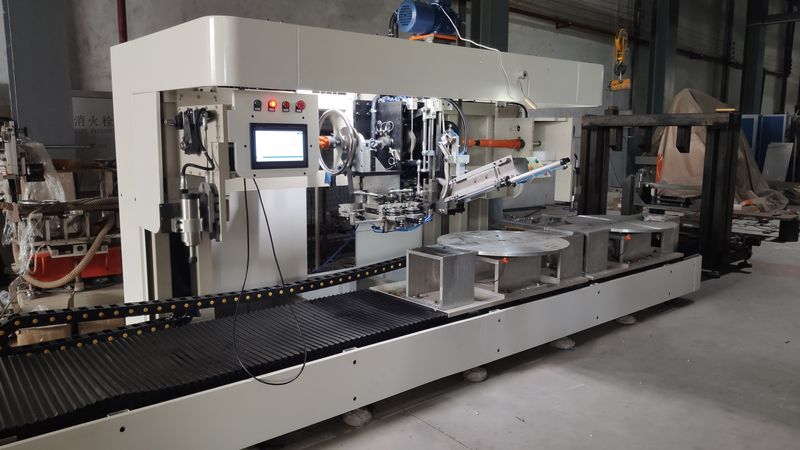Meixin Comb Brush Machinery
A leader in this industry ,specializing in brush making machine line for more than 14 years
Introduction
Brush machines have come essential tools in the manufacturing assiduity, streamlining the product of skirmishes for colorful operations. As we explored in our former composition on the elaboration of Brush machines, these remarkable biases have experienced significant advancements, integrating automated capabilities and advanced technologies. Now, in this composition, we will claw deeper into the content and concentrate on optimizing the effectiveness of Brush machines to drive productivity and quality to new heights. By enforcing ways and stylish practices specifically acclimatized for Brush machine operations, manufacturers can unleash the full eventuality of these machines, performing in bettered performance, increased affair, and enhanced overall effectiveness. Let's explore the strategies that can help manufacturers make the utmost of their Brush machines and achieve remarkable results in Brush products.
1. Workflow Analysis
Assaying the workflow of Brush machine operations is the first step in optimizing effectiveness. By assessing the entire product process, from raw material medication to finished product packaging, manufacturers can identify any backups, redundancies, or gratuitous ways that hamper productivity. Streamlining the workflow through the elimination or streamlining of similar inefficiencies enables manufacturers to minimize time-out, reduce material waste, and completely maximize the application of their Brush machines. This leads to bettered overall effectiveness, increased affair, and a more competitive manufacturing process.
2. Machine Calibration and Setup
Proper estimation and setup of Brush machines are essential for achieving optimal performance. Ensure that the machine is rightly aligned and calibrated according to the specifications handed by the manufacturer. This includes conforming Brush height, speed, and pressure settings to match the asked brush characteristics. Regularly check and replace or damaged factors to maintain perfection and delicacy in Brush product. Figure 1 3 Axis Drilling and Tufting Machine Mx201 for flat Brush, comber Brush, and slice Brush.

3. Tooling Optimization
The selection and optimization of driving significantly impact the effectiveness of Brush machines. Choose applicable Brush molds, institutions, and cutting tools that are specifically designed for the asked brush type and material. Fine-tune the tooling parameters to achieve the asked brush characteristics, similar to bristle length, viscosity, and pattern. Nonstop monitoring and adaptation of driving to ensure harmonious and high-quality Brush products.
4. Material Handling and Feeding
Effective material running and feeding processes are pivotal for continued Brush product. Enforcing automated systems for material feeding, similar to conveyor belts or robotic arms, minimizes homemade intervention and ensures a steady force of raw accouterments. These automated systems can be equipped with detectors and controls to precisely regulate the material inflow and minimize waste. Optimizing material running involves organizing and arranging the raw accouterments in a logical and accessible manner. This reduces the time and trouble needed for drivers to recoup and load accouterments into the Brush machine. Effective material storehouse and reclamation systems, similar to designated lockers or racks, grease smooth and nippy material running, further enhancing overall productivity. Likewise, integrating material-seeing technologies can enhance the effectiveness of material feeding. These detectors can descry the presence and position of accouterments, allowing for automatic adaptations in the feeding process. This not only reduces the threat of crimes and logjams but also optimizes material operation and minimizes waste. By prioritizing effective material running and feeding, manufacturers can achieve a streamlined and nonstop product process. This reduces time-out, maximizes the application of the Brush machine, and eventually improves overall functional effectiveness and productivity.

5. Quality Control Systems
Integrating robust quality control systems into Brush machines is vital for effective products. Apply detectors, cameras, and dimension bias to cover critical parameters during the production process. Real-time data analysis can descry variations or blights in the skirmishes, allowing for immediate corrective action. By relating and addressing quality issues beforehand, manufacturers can avoid waste, rework, and client dissatisfaction.
6. Operator Training and Continuous Improvements
Well-trained drivers who understand the complications of Brush machines play a vital part in optimizing effectiveness. Give comprehensive training programs to drivers, covering machine operation, troubleshooting, and conservation. Encourage a culture of nonstop enhancement, where drivers can give feedback, suggest process advancements, and share stylish practices. Regularly review and update training accouterments to keep drivers up to date with the rearmost advancements in Brush machine technology.
Conclusion
Optimizing the effectiveness of Brush machines is essential for manufacturers seeking to enhance productivity, ameliorate quality, and stay competitive in the request. By assaying workflows, calibrating machines, optimizing tooling, enforcing effective material running processes, integrating quality control systems, and investing in driver training, manufacturers can unleash the full eventuality of their Brush machines. Workflow analysis enables manufacturers to identify areas of enhancement, streamline operations, and exclude backups. Calibrating machines according to specifications ensures precise and accurate Brush products. Optimizing driving selection and parameters fine- melodies the affair to meet asked brush characteristics. Effective material running processes, similar to automated feeding systems, minimize time-out and maintain a steady product inflow. Integrating quality control systems allows for real-time monitoring and immediate corrective action, reducing waste and enhancing product thickness.
Copyright © 2023 Meixin Comb Brush Machinery Co., Ltd. | All Rights Reserved